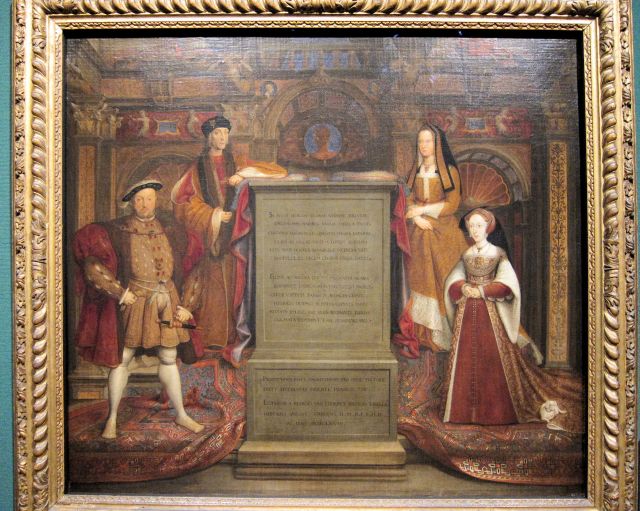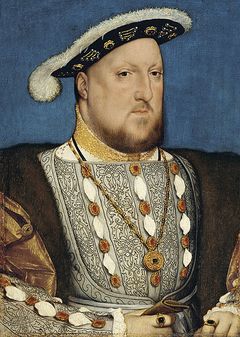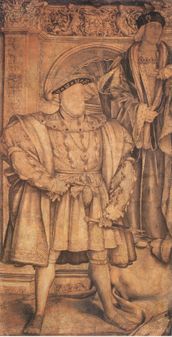Whitehall Palace mural portrait of Henry VIII (lost Hans Holbein painting; 1537): Difference between revisions
No edit summary |
mNo edit summary |
||
| (One intermediate revision by one other user not shown) | |||
| Line 1: | Line 1: | ||
{{InfoboxLost | {{InfoboxLost | ||
|title=<center>Whitehall Palace mural</center> | |title=<center>Whitehall Palace mural</center> | ||
| Line 8: | Line 7: | ||
Employed as the King's painter in 1536, Hans Holbein the Younger painted, in 1537, a mural depicting '''King Henry VIII''', his late father Henry VII, his mother Elizabeth of York, and his then-wife Jane Seymour. | Employed as the King's painter in 1536, Hans Holbein the Younger painted, in 1537, a mural depicting '''King Henry VIII''', his late father Henry VII, his mother Elizabeth of York, and his then-wife Jane Seymour. | ||
It was considered Holbein's greatest achievement and includes the most well-known depiction of Henry VIII, despite the fact that the mural was destroyed by an accidental fire in Whitehall Palace in 1698. | It was considered Holbein's greatest achievement and includes the most well-known depiction of Henry VIII,<ref>Strong, 5. Strong calls it "arguably the most famous royal portrait of all time, encapsulating in this gargantuan image all the pretensions of a man who cast himself as 'the only Supreme Head in earth of the Church of England'."</ref> despite the fact that the mural was destroyed by an accidental fire in Whitehall Palace in 1698. | ||
The original mural survived intact in the Privy Chamber of the palace for 162 years, during which time prints were made of the painting, and in 1667, Remegius van Leemput painted a full copy of the piece, although at a much smaller scale than the mural, which had been life-sized, depicting the four figures at their full height. | The original mural survived intact in the Privy Chamber of the palace for 162 years, during which time prints were made of the painting, and in 1667, Remegius van Leemput painted a full copy of the piece, although at a much smaller scale than the mural, which had been life-sized, depicting the four figures at their full height.<ref>Buck, Stephanie. Hans Holbein, Cologne: Könemann, 1999. p. 115. ISBN 3-8290-2583-1.</ref> | ||
A half-portrait of the king by Holbein has survived, as well as the left-hand section of the pencil sketch for the mural. In that era, when preparing for larger paintings, artists would generally draw a full-scale paper draft in great detail before commencing their final piece on board or, in this case, wall. | A half-portrait of the king by Holbein has survived, as well as the left-hand section of the pencil sketch for the mural. In that era, when preparing for larger paintings, artists would generally draw a full-scale paper draft in great detail before commencing their final piece on board or, in this case, wall. | ||
| Line 21: | Line 20: | ||
File:Henry VIII and Henry VII, by Hans Holbein the Younger.jpg|The surviving section of Holbein's sketch for the mural. | File:Henry VIII and Henry VII, by Hans Holbein the Younger.jpg|The surviving section of Holbein's sketch for the mural. | ||
</gallery> | </gallery> | ||
==References== | |||
{{reflist}} | |||
==External Link== | |||
https://en.wikipedia.org/wiki/Portrait_of_Henry_VIII | |||
[[Category:Miscellaneous lost media]] | [[Category:Miscellaneous lost media]] | ||
[[Category:Completely lost media]] | |||
[[Category:Historic]] | [[Category:Historic]] | ||
Latest revision as of 21:26, 9 November 2022
Employed as the King's painter in 1536, Hans Holbein the Younger painted, in 1537, a mural depicting King Henry VIII, his late father Henry VII, his mother Elizabeth of York, and his then-wife Jane Seymour.
It was considered Holbein's greatest achievement and includes the most well-known depiction of Henry VIII,[1] despite the fact that the mural was destroyed by an accidental fire in Whitehall Palace in 1698.
The original mural survived intact in the Privy Chamber of the palace for 162 years, during which time prints were made of the painting, and in 1667, Remegius van Leemput painted a full copy of the piece, although at a much smaller scale than the mural, which had been life-sized, depicting the four figures at their full height.[2]
A half-portrait of the king by Holbein has survived, as well as the left-hand section of the pencil sketch for the mural. In that era, when preparing for larger paintings, artists would generally draw a full-scale paper draft in great detail before commencing their final piece on board or, in this case, wall.
Most paintings of Henry VIII, including portraits with him as a lone figure, are based, ultimately, on this lost original.
Gallery
References
- ↑ Strong, 5. Strong calls it "arguably the most famous royal portrait of all time, encapsulating in this gargantuan image all the pretensions of a man who cast himself as 'the only Supreme Head in earth of the Church of England'."
- ↑ Buck, Stephanie. Hans Holbein, Cologne: Könemann, 1999. p. 115. ISBN 3-8290-2583-1.


